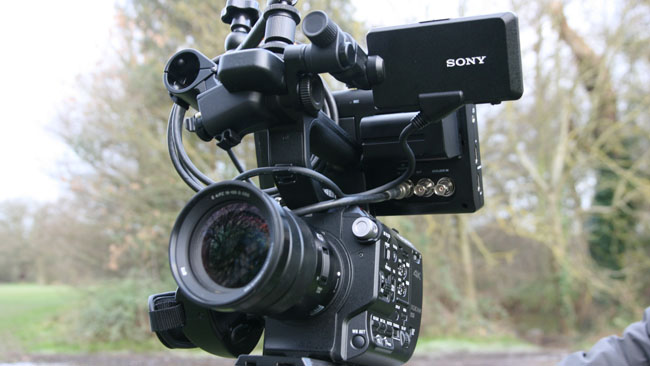
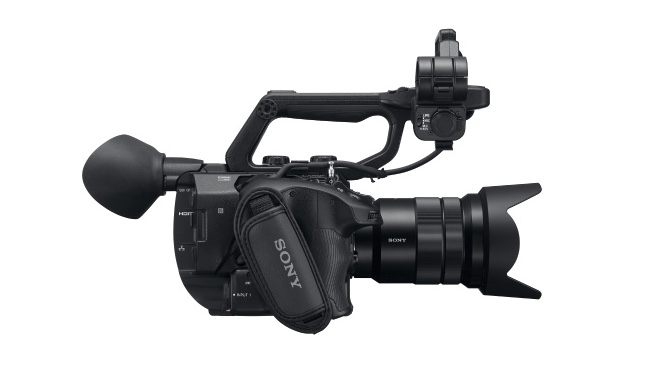 The new Sony FS5
The new Sony FS5
RedShark replay: We continue our countdown of the Top Ten stories we've run on our site over the course of 2016 with this detailed look at the Sony FS5, a small yet powerful 4K shooter, and considers its place in an increasingly crowded market.
The Complete Top 10 (based on page views)
1. Nvidia's GTX 1080 Is this the end of Mac-based video production?
2. Five things a Colorist would like to say to a DP
3. Is something dramatic about to happen with Final Cut Pro X?
4. This is how good Canon’s low light camera is
5. Apple could dominate the entire NLE space with the next Final Cut Pro
6. Is Lytro's new 755MP, 300fps cinema camera the biggest leap in video tech ever?
7. Sony's new PXW-Z150: the camera you should always take with you?
8. RED launches not one, but two 8K cameras
9. Sony FS5 Review: How good is Sony's latest large sensor camera?
10. Surprise new Super 8 camera from Kodak
Sony FS5 Review: How good is Sony's latest large sensor camera?
Technology restricts product design far less than it ever has. This creates both benefits and problems – benefits because designers can dream big and give us a lot of capability for comparatively little money and problems because the market still needs a product range.
This situation has been expressed by Sony recently, inasmuch as the range of cameras it aims at filmmaking is currently very complete. It has the F65 at the top-end and the F55 to compete with Alexa and F5 if we're not quite that rich, then FS7 for the independent scene and a good few FS700s still hanging around doing very adequate work. There have been few cameras with long-term value and upgradability as good as the FS700 had at launch. All of that's before we consider the company's extremely well-received A7 DSLR series which really has outstanding capability.
Sony FS5 – the FS7's diminutive sibling
It's a crowded pool, then, into which jumps the FS5, and it would be easy to view it as a camera too far. Price-wise, it sits between the best DSLRs and the cheapest super35 filmmakers' cameras, which is a turbulent place at the best of times, so it has to be not only distinctive among the masses, but also a powerful performer in its own right.
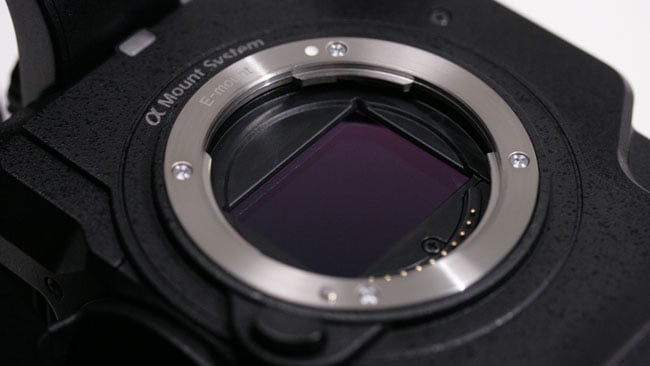 The FS5 uses the same sensor as the excellent FS7.
The FS5 uses the same sensor as the excellent FS7.
Happily, it is. The pictures recall the FS7, which makes sense given it's the same sensor, but it's different because it's very small and very lightweight, which goes a long way to offsetting the traditional, awkward handycam-style side grip. That is, after all, what a basic Ursa Mini comes with, but the Blackmagic is far too heavy for those particular ergonomics to be in any sense practical without the shoulder kit. FS5 is not built as heavily and it's much smaller – taking into account the depth of the battery compartment, the actual camera hardware occupies a space barely five or six inches square by three deep, give or take a few protrusions. The layout is similar to FS7 and the viewfinding is similarly, well, okay for the money. Nevertheless, the size and weight mean it maintains its handiness better than a larger, heavier camera of the same layout.
Features and layout
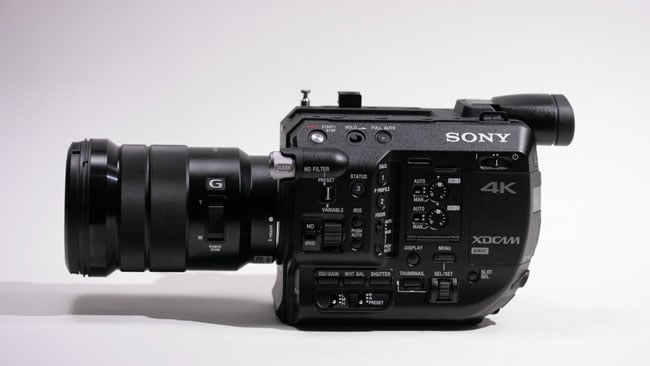 Without the top handle, the camera is small, and could be even less noticeable with a smaller lens.
Without the top handle, the camera is small, and could be even less noticeable with a smaller lens.
The camera sports a feature that we liked on JVC's GY-LS300 – the removable top handle, which, like the JVC, sports an electronic interface. The FS5's handle provides services, including Sony's proprietary hot shoe, offering power and signal connectivity with such accessories as radio mic receivers. With the handle, it's capable. Without it, it's tiny (and nevertheless retains one balanced audio input). Other layout highlights include the various viewfinder mounting positions, which approximate a rosette but aren't quite, and the shallow, highly-adaptable E-mount for lenses. We've talked about shallow mounts a lot, so let's just say that the E mount offers many of the same compatibility advantages as micro four-thirds, albeit with a whiff of vendor lock-in about it.
Sony supplied the SELP18105G lens, which, as the type number suggests, is an 18-105mm zoom. It's only f/4, but at least it maintains that stop all the way down to the long end, unlike the 18-200 version which falls off to f/6.3 at 200mm. The complaint, as ever, is that entirely electronic lenses with servoactuated mechanisms are horrible in motion picture applications and that complaint stands. Nonetheless, it doesn't feel quite so out of place on the diminutive, £5,000 FS5 as it might feel on bigger, pricier cameras. Again, the mount is flexible, but one feels as if putting a B4-mount or Canon CN lens on this camera isn't really the purpose of the endeavour anyway. It's tiny, let it stay that way.
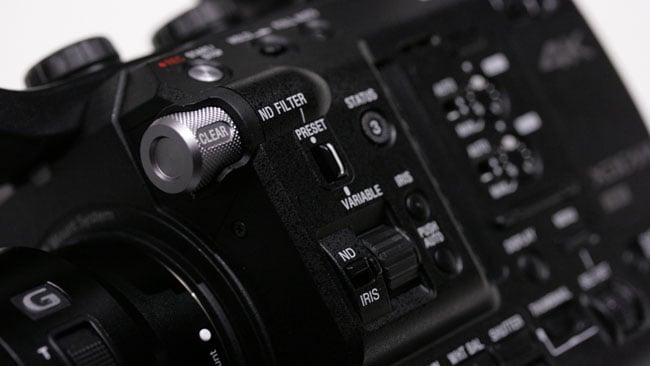 The FS5 uses an electronic ND filter, but the controls work conventionally nonetheless.
The FS5 uses an electronic ND filter, but the controls work conventionally nonetheless.
Before we get down to imaging, the final practical concern is that famous electronic ND filter. It's not entirely solid state, being motored out of the way in order to achieve a true "clear" setting, but otherwise the ability to have smoothly-variable neutral density is both novel and welcome. The FS5 offers S-Log2 and S-Log3 modes for high-dynamic-range shooting, and in these modes, as with many of its brother and sister cameras, the minimum sensitivity is high, in order to drag the maximum possible shadow detail out of the sensor's extreme low-end exposure range.
ND is naturally crucial here and the inbuilt device goes smoothly down to 1/128 or six stops. If there's any colour shift, I couldn't see it. Control of neutral density filtration is provided on a rotary control with mechanical design to approximate the feel of a mechanical filter wheel. It seems as if this, along with the provision of physical toggle switches for gain and white balance, is where some of that £5000 went.
Image and output
We have been impressed with Sony's ability to manufacture capable sensors at consumer pricepoints since the A7S, which raised a few eyebrows in both technical and aesthetic assessments. Reputedly, the sensor in the FS5 is the same as that in the FS7 and the capability certainly seems to be similar. The principal difference is in the way the headline slow motion capture works – the FS5 works much the same way as the FS700, buffering up a few seconds' worth of capture before writing it out to the SD card. The FS7 can, within certain limits, shoot unbounded amounts of slowmo. This seems like a reasonable differentiation and doesn't shear the camera completely of key features. The only issue is that, as with other Sony cameras, the highest frame rates are available only with the camera set to 60Hz mode and it won't shoot both 60 and 50 modes onto the same card, requiring a reboot and a fresh card (or a format). This is awkward at best and seems like a software issue that's well overdue for attention.
The quality question is really one of how well it's recorded. The FS5 lacks the intra-frame XAVC modes of its big brother, maxing out at 100mbps in 4K. (XAVC is Sony's own h.264-derived codec.) At conventional frame rates and in HD, it's a just-about-adequate 50-megabit camera, although naturally, it would be entirely reasonable to shoot 4K and then downres to, say, ProRes in post to achieve 100-megabit overall bandwidth and greater colour precision in an HD picture. It's important to note that some current SD cards achieve 150MBps (1200mbps), double the rate required to record the most demanding 600mbps modes of XAVC-I, so other than concerns over high-speed recording, there is no direct requirement for a different codec for the SD-card-based machine. The choice of formats is not one imposed by technical necessity; it's a forgivable way to differentiate two devices, perhaps.
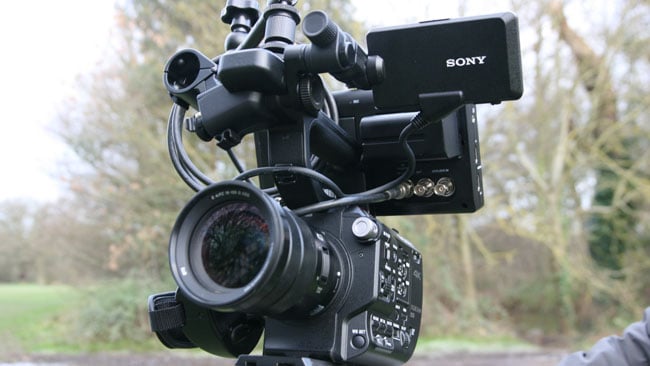 Shooting the demo material with the FS5 and an Atomos Shogun.
Shooting the demo material with the FS5 and an Atomos Shogun.
People looking for more will naturally turn to the idea of external recording. The FS5 has a 10-bit SDI output (and eight-bit HDMI); while the JVC GY-LS300 only offers eight-bit SDI, it's also about £2000 cheaper. 8-bit outputs would have been hard to overlook on the FS5. Convergent Design is already talking about supporting raw output on the FS5 and this, if implemented, would put FS5 on a surprisingly level playing field with something like an Ursa Mini, give or take the viewfinder. What the FS5 mainly lacks is any sort of output LUT capability; if you shoot SLog, you can view a normalisation in the viewfinder, but external equipment (hundreds to around a thousand for a LUT box) is required to do much else. But then again, if you've an Odyssey on top, you've got that anyway.
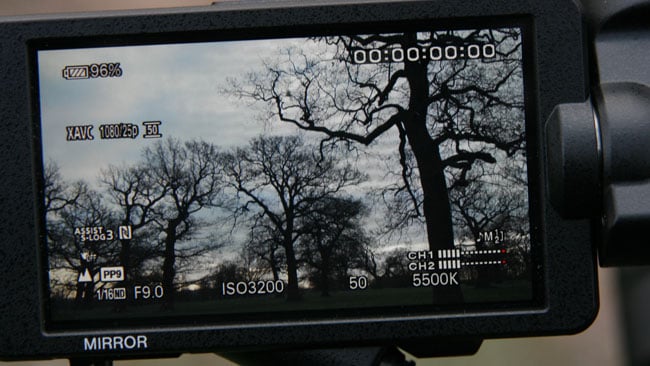 Notice the viewfinder indication confirming that S-Log3 viewing is enabled. This is the camera's only LUT capability.
Notice the viewfinder indication confirming that S-Log3 viewing is enabled. This is the camera's only LUT capability.
Closing thoughts
A complainer might complain, then, that the FS5 requires a lot of accessorisation for high-end work, which is true, but it's also a tiny little thing with a lot of expandability. These are really two ways of expressing the same situation, the relevance of each depending on the task at hand. On the face of it, it seems a shame to load down such an eager little device with excessive ironmongery, but adding something as simple as a Tilta BS-T03 would put the FS5 in a very similar place to, say, the Ursa Mini – but with more frame rates, vastly cheaper media, more dynamic range and the FS5 would probably still be lighter. Add an Atomos Shogun for ProRes and the pricing and clumsiness factor might swing the argument back the other way. Launch the Ursa 4.6K and things become even more interesting. There's an argument that the price gap between FS5 and FS7 could be a bit larger, given the ancillary services (such as LUTs) that the FS5 lacks, but in such a crowded market, it's difficult to take into account every possible point of view. While there are many cameras to compare, then, there's also enough points of differentiation to suggest that there might well be room for them all.
Tags: Production


Comments